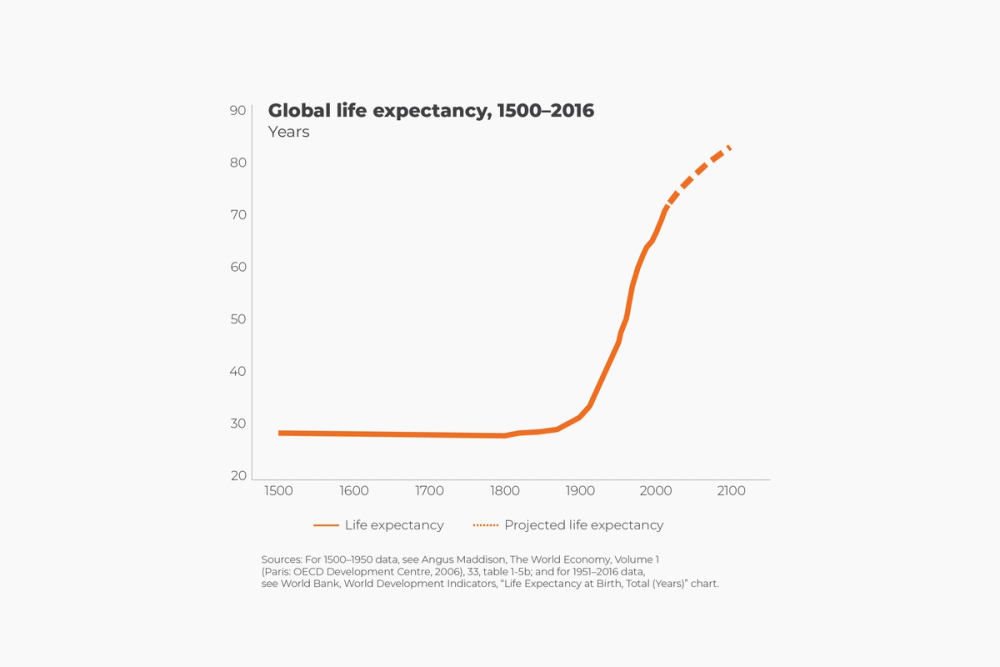Longer lives are valuable, for a while
Why healthspan matters more than lifespan
For much of human history, longevity wasn't a major concern—most people didn't live long enough to worry about old age. However, in recent decades, life expectancy has significantly increased. Two centuries ago, the average lifespan was around 30 years. Today, global life expectancy has more than doubled to 72 years, and experts project it could reach 81 by the year 2100.

The Longevity Paradox: More Years, But at What Cost?
While the achievement of a longer lifespan is remarkable, it introduces its own set of challenges, particularly in high-income countries where people increasingly question whether living longer also means living better. The key issue is ensuring that these extended lives are healthier, more fulfilling, and economically sustainable. Otherwise, what’s the point? This dilemma underscores the importance of focusing not just on lifespan—the total years lived—but on healthspan—the years lived in good health.
For instance, in the Netherlands, the average life expectancy is 80 years for men and 83 years for women. However, the healthy lifespan is significantly shorter: men remain healthy until around 64 years, while women stay healthy until about 62.5 years. The U.S. faces a similar issue, with a notable gap between life expectancy and healthy lifespan. In the U.S., men generally remain healthy until around 66 years, and women until about 68 years, even though the overall life expectancy is around 76 years for men and 81 years for women.
Rethinking Healthcare: Beyond Just Adding Years
Many people hesitate to actively pursue a longer life if it comes with constant sacrifices. A healthy lifestyle requires ongoing attention, such as watching your weight, not smoking, moderating alcohol consumption, and staying active. This constantly forces a balance between short-term pleasures and long-term health.
Modern medicine extends lives, even for those who make unhealthy choices, but this puts a strain on society. The rising costs of healthcare for a growing group of vulnerable elderly people call for a shift towards preventive care. Instead of researching and treating diseases like dementia, heart disease, and cancer separately, the solution lies in promoting healthy aging, thereby reducing the risk of various age-related diseases simultaneously.
Singapore offers an inspiring example. Since 2022, healthcare there is funded based on the overall health of the population, encouraging hospitals to promote preventive care. As a result, the population remains healthier, and expensive treatments are less frequently needed. With measures like taxes on unhealthy food and investments in public transport to encourage physical activity, Singapore leads the world in healthy aging.
This approach is more sustainable and better for both individuals and society. Without focusing on adding healthy years to life, we risk prioritizing quantity over quality when it comes to living longer.
The Economic Case for Healthy Aging
From an economic perspective, extending the number of years people live in good health can bring significant benefits. In the Netherlands, the value of an additional year in good health—measured as a quality-adjusted life year (QALY)—is typically estimated between €20,000 and €80,000. This reflects how trade-offs are made when it comes to investments in improving health and extending life. Other countries use different amounts but similar calculations.
Estimates suggest that extending the healthy lifespan of a population can have a positive impact on economic growth. Some studies indicate that improving global healthy life expectancy by just five years could add trillions of dollars to global GDP in the long run, through higher productivity, lower healthcare costs, and greater labor force participation.
These figures highlight the profound impact that healthier aging can have, not only on the well-being of individuals but also on economies and societies as a whole.
A Path Forward: Aligning Lifespan and Healthspan
To extend our healthy years, both personal and societal changes are needed. On a personal level, we need to rethink the plans we make for a longer life—this includes making healthier choices, staying active, engaging in meaningful work, and nurturing relationships. On a societal level, we must prioritize preventive healthcare, create age-friendly workplaces, improve public transportation, and invest in communities that keep people connected and engaged.
If the gap between our lifespan and our healthy years widens, it will place pressure on both individuals and society. Governments must make promoting healthy aging a priority, as the long-term benefits far outweigh the costs.
- 1The Longevity Imperative by Andrew J. Scott
